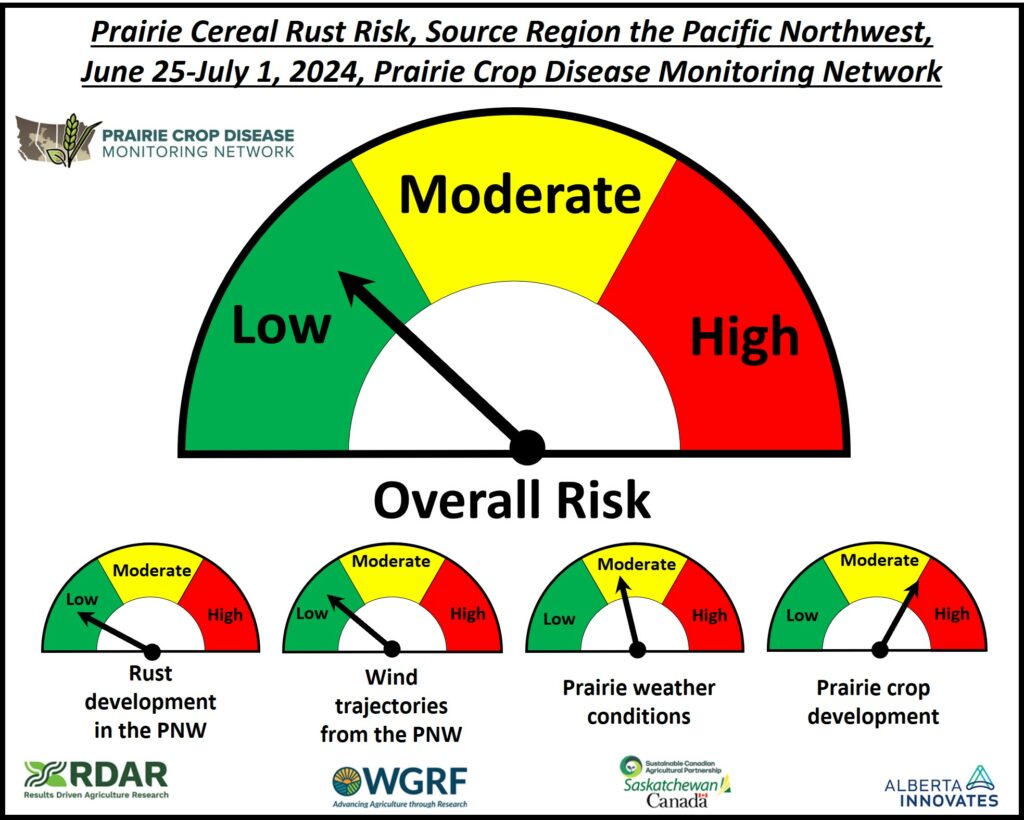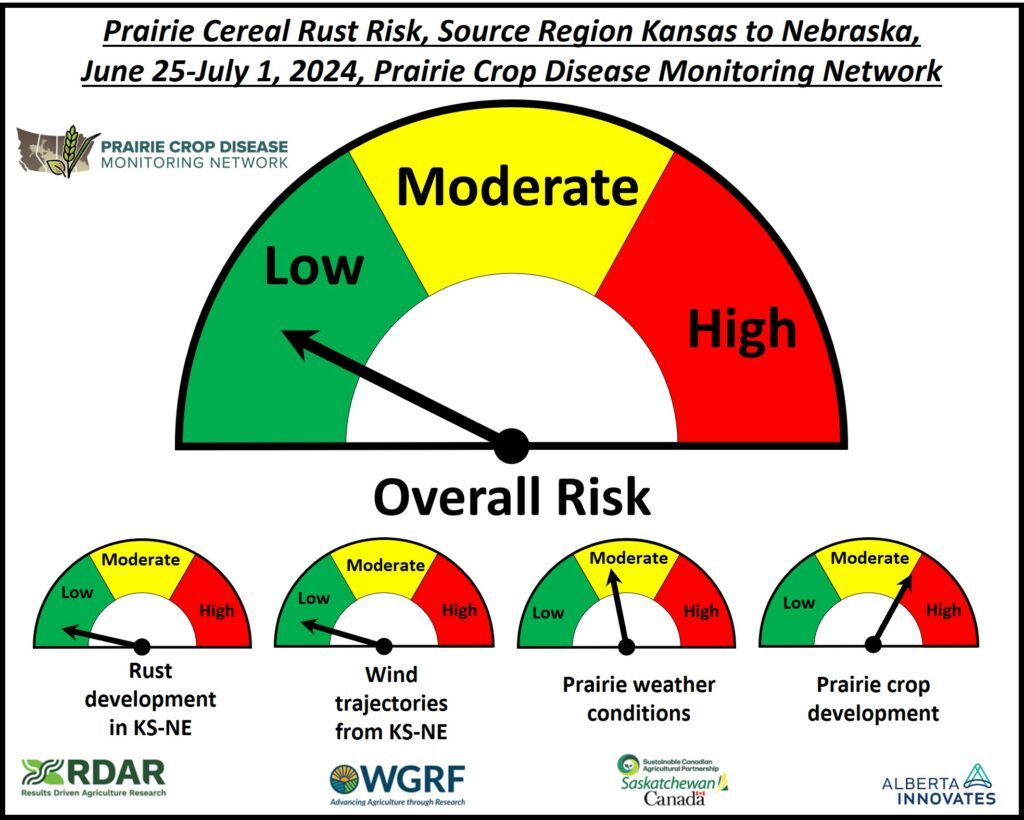The eighth weekly Prairie wind trajectory cereal rust risk report for 2024 is available for download now at the following link: June 25-July 1, 2024, report.
As of the week of June 25-July 1, 2024, the overall Prairie cereal rust risk assessment and need for in-crop scouting is as follows:
Pacific Northwest – There were lower numbers of reverse wind trajectories that passed over the PNW region and into the Prairies versus previous weeks, while stripe rust development is limited in commercial fields. Prairie winter wheat crops are generally progressing from flowering to grain filling, while much of the spring wheat crop is moving into to the tillering, stem elongation, and heading stages. This past week (June 24-30, 2024) increased rainfall occurred mainly in Saskatchewan and Manitoba although rainfall events did occur in other regions. Overall, as of July 3, 2024, the risk of stripe rust appearance from the PNW is low and scouting for this disease in the Prairie region resulting from PNW rust inoculum is generally not urgent, although areas with an increased number of trajectories may be at higher risk. The recent appearance of stripe rust in Montana brings the stripe rust issue very close to the Prairies, especially the central to western regions, so scouting for stripe rust is advised for fields planted to varieties that have susceptible to intermediate resistance ratings.

Kansas-Nebraska corridor – There were a low number of reverse wind trajectories that passed over the KS/NE region and into the Prairies from June 25 to July 1, 2024. Although there were earlier reports of stripe and leaf rust in KS/NE, winter wheat crops in these two states are either harvested or moving rapidly towards maturity. Therefore, the KS/NE winter wheat will no longer represent a significant source of rust inoculum. Prairie winter wheat crops are generally progressing from flowering to grain filling, while much of the spring wheat crop is moving into to the tillering, stem elongation, and heading stages. This past week (June 24-30, 2024) increased rainfall occurred mainly in Saskatchewan and Manitoba although rainfall events did occur in other regions. Rainfall in regions with higher amounts could facilitate deposition of rust spores into cereal crops and subsequent disease development. Overall, as of July 3, 2024, the risk of stem, leaf, stripe, and crown rust appearance from Kansas-Nebraska corridor inoculum is low and scouting for these diseases in the Prairies is generally not urgent, although areas with an increased number of trajectories may be at higher risk. Stripe rust observations from North Dakota, South Dakota, Minnesota and Wisconsin have brought the stripe rust issue very close to the Prairies, especially the central to eastern regions. Thus, scouting for stripe rust is advised for fields planted to varieties that have susceptible to intermediate resistance ratings, especially in the central to eastern Prairie regions.

Prairie winter wheat fields continue to be at risk as they have mostly headed and are moving into the grain filling period although rust impacts start to decrease versus if rust appears prior to head emergence. Fortunately most current winter wheat varieties have intermediate to high levels of resistance, although AC Radiant, CDC Buteo, AAC Elevate, Broadview, and CDC Falcon are rated as susceptible (2024 AB Variety Guide; 2024 Variety Guide; 2024 MB Variety Guide). In terms of spring wheat (various classes) and durum the following varieties are either an S or MS: 5700PR, AAC Cameron, AAC Iceberg, AAC Tisdale, AAC Tomkins, AAC Warman, AAC Whitefox, AC Foremost , Cardale, CDC Abound, CDC Adamant, CDC Flare, CDC Pilar, Faller, Prosper, SY Natron, SY Rorke, SY Torach, and Unity. If you are growing a stripe rust susceptible variety, it will be important to keep an eye on your crops for stripe rust and follow further PCDMN cereal risk updates (https://prairiecropdisease.com/cereal-rust-risk/).
Given the recent appearance of stripe rust in commercial fields in south central Manitoba and south-central Saskatchewan, local sources of stripe rust spores are now an important consideration. Thus, wheat producers in these regions are encouraged to be on the look out for stripe rust in fields planted to varieties with susceptible to intermediate stripe rust reactions.
One question producers and consultants may have is in relation to fungicide timing for stripe rust. In general, for wheat leaf spot diseases such as tan spot and the septoria complex the key leaves are in the upper canopy, especially the flag leaf and penultimate (second leaf from the head) leaves. A previous PCDMN covers scouting and risk assessment recommendations for cereal leaf spot diseases. For leaf spots such as tan spot and the septoria complex in wheat, and scald, both forms of net blotch and spot blotch in barley, fungicide at herbicide application timings do not provide the best response in terms of disease management and crop productivity.
Exceptions occur with cereal rust diseases, especially stripe rust, where a herbicide timing application can be more useful. This is likely due to the biotrophic nature (i.e. they derive nutrients from living host tissues) of the rust pathogens and that initial rust inoculum typically comes from outside the crop, especially for spring cereals. In contrast, cereal leaf spot diseases (scald, net blotch, spot blotch, tan spot, septorias) are necrotrophic in nature (i.e. the derive nutrients from dead plant tissue), while initial inoculum typically comes from old crop residues in the same field where the crop is growing. Fungicide movement to the rust pathogen in living host tissues may be more extensive versus through dead plant tissues in the case of necrotrophic leaf spot pathogens. In addition, cereal leaf spot inoculum is continuously produced from old crop residues and thus can infect any new leaves produced immediately after spraying has occurred.
Once stripe rust appears in a Prairie wheat crop further development is favoured by moist humid conditions and cool to moderate temperatures. Based on information from Dr. X. Chen, WSU, Pullman, Washington, fungicide application for stripe rust is recommended from the herbicide timing stage through to flowering when the % of plants infected or the area of leaf infection approaches 5%. Staying on top of an emerging stripe rust problem in your Prairie winter or spring wheat crop is critical as yield losses are greatly increased when the disease becomes established, especially before head emergence. NOTE: pay close attention to labels for fungicides especially post-head emergence options in relation to timing, pre-harvest intervals and maximum residue limits. Consult your provincial guides to crop protection for more information (AB Guide, SK Guide, MB Guide).

